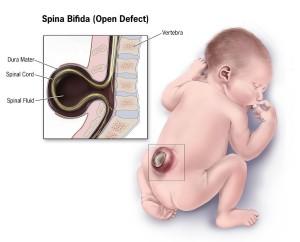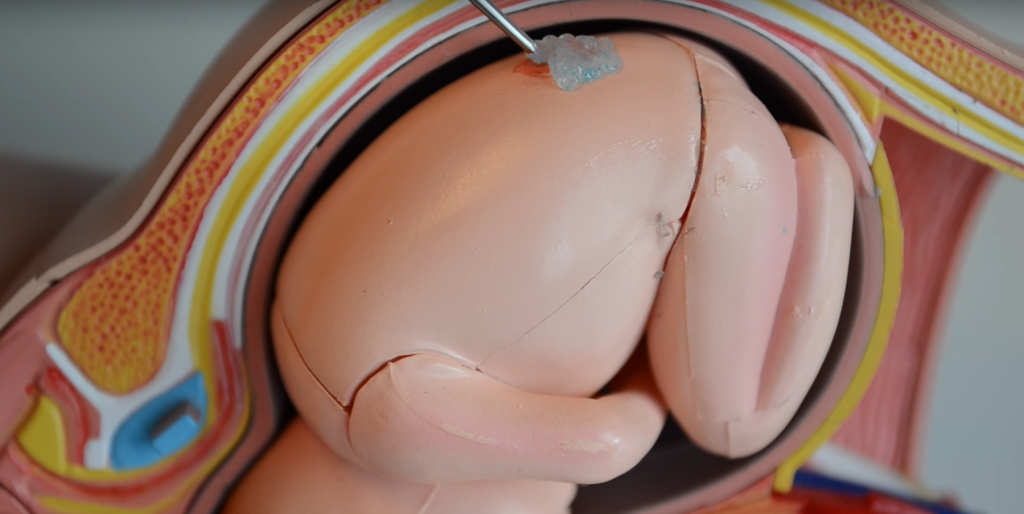 Researchers from Leiden University and Erasmus medical centers recently received the prestigious €50,000 Open Mind grant from science and tech foundation STW to continue developing their early term surgical procedure to prevent spina bifida. Professor Dick Oepkes from LUMC and Alex Eggink of Erasmus MC developed a surgical solution to the common birth defect that will correct the gaps on the backs of developing fetuses. The minimally invasive procedure is performed early in pregnancy and uses a revolutionary in utero 3D printing technique to prevent the fetus’ spine and nerves from being damaged by its mother’s amniotic fluid.
Researchers from Leiden University and Erasmus medical centers recently received the prestigious €50,000 Open Mind grant from science and tech foundation STW to continue developing their early term surgical procedure to prevent spina bifida. Professor Dick Oepkes from LUMC and Alex Eggink of Erasmus MC developed a surgical solution to the common birth defect that will correct the gaps on the backs of developing fetuses. The minimally invasive procedure is performed early in pregnancy and uses a revolutionary in utero 3D printing technique to prevent the fetus’ spine and nerves from being damaged by its mother’s amniotic fluid.
Spina bifida is a birth defect where a the backbone and membranes around the spinal cord do not completely close around them. The condition affects between 1,500 and 2,000 of the 4 million babies born in the US every year, and there is currently an estimated 166,000 people living with spina bifida. While spina bifida can be detected early in pregnancy, the current options for correcting it are limited. Parents can choose to either end the pregnancy early, or choose a dangerous surgery that can be very stressful and difficult on both the mother and fetus.
The early surgical procedure involves opening the mother’s womb and operating on the fetus, but by the time that option is available several toxic substances from the amniotic fluid have already caused irreversible damage to the fetus’ nerves. In addition to mobility issues, other complications can include serious latex allergies, a dangerous buildup of cerebrospinal fluid in the head and ongoing incontinence issues. Spina bifida can also cause problems with cognitive control, developmental and learning difficulties and severe ADHD.
“After birth the surgeon closes the defect on the back to cover the nerves. However, this is not a cure. The nerves are already damaged before birth; these children are wheelchair-bound for the rest of their life,” explained Oepkes during his pitch to receive the Open Mind grant.
The 3D printing technique that Oepkes and his team of fellow researchers developed, one of several similar procedures being developed all over the world, could be used extremely early in the pregnancy. Not only is it far easier and considerably safer, but it would potentially offer much better results and could prevent most cases of spina bifida from developing far enough along to cause many of the difficulties faced by those living with the condition today. The 3D printed seal is completely flexible and will grow with the fetus as it develops in it’s mother’s womb. If Oepkes research program progresses as currently planned the treatment could be available within the next few years.
Here is some video of Oepkes discussing this new surgical procedure:
STW is a large Dutch technology foundation that has a €101 million yearly operating budget funded by the Netherlands Organization for Scientific Research, the Ministry of Education, Culture and Science and the Ministry for Economic Affairs. They also receive significant funding from private donors and business financing partners. Their Open Mind grant was designed to challenge scientists to think of out of the box solutions, to develop original and risky lines of research in the tech and medical fields that can create social impact. Discuss this story in the Spina Bifida / 3D Printing forum thread on 3DPB.com.
Subscribe to Our Email Newsletter
Stay up-to-date on all the latest news from the 3D printing industry and receive information and offers from third party vendors.
You May Also Like
NSF Awards Kentucky $1M for Advanced Manufacturing
The National Science Foundation has awarded a $1 million grant to the University of Louisville for the Advancing Manufacturing and Building Construction Technologies (NSF AMT) project. This initiative is part...
3D Printing News Briefs, May 11, 2024: 3D Printed Stent, Tower, Sculptures, & More
We’re starting off with medical research in today’s 3D Printing News Briefs, as researchers in Korea used CT images and 3D printing to fabricate an educational simulator for a mastoidectomy....
3D Printing Unpeeled: Wind Turbines, Probiotics and Lenses
TPI Composites, ORNL and Ingersoll Rand are working to make wind turbine tooling segments that can be 18.3 meters long. These elements also include resistive wires that help keep the...
Tethon 3D Releases Cost-effective Bioprinter
Tethon 3D, known for its ceramic-loaded DLP materials, custom resins, and DLP 3D printers, has recently released a bioprinter. Vat polymerization printers like DLP systems have been widely used by...
































